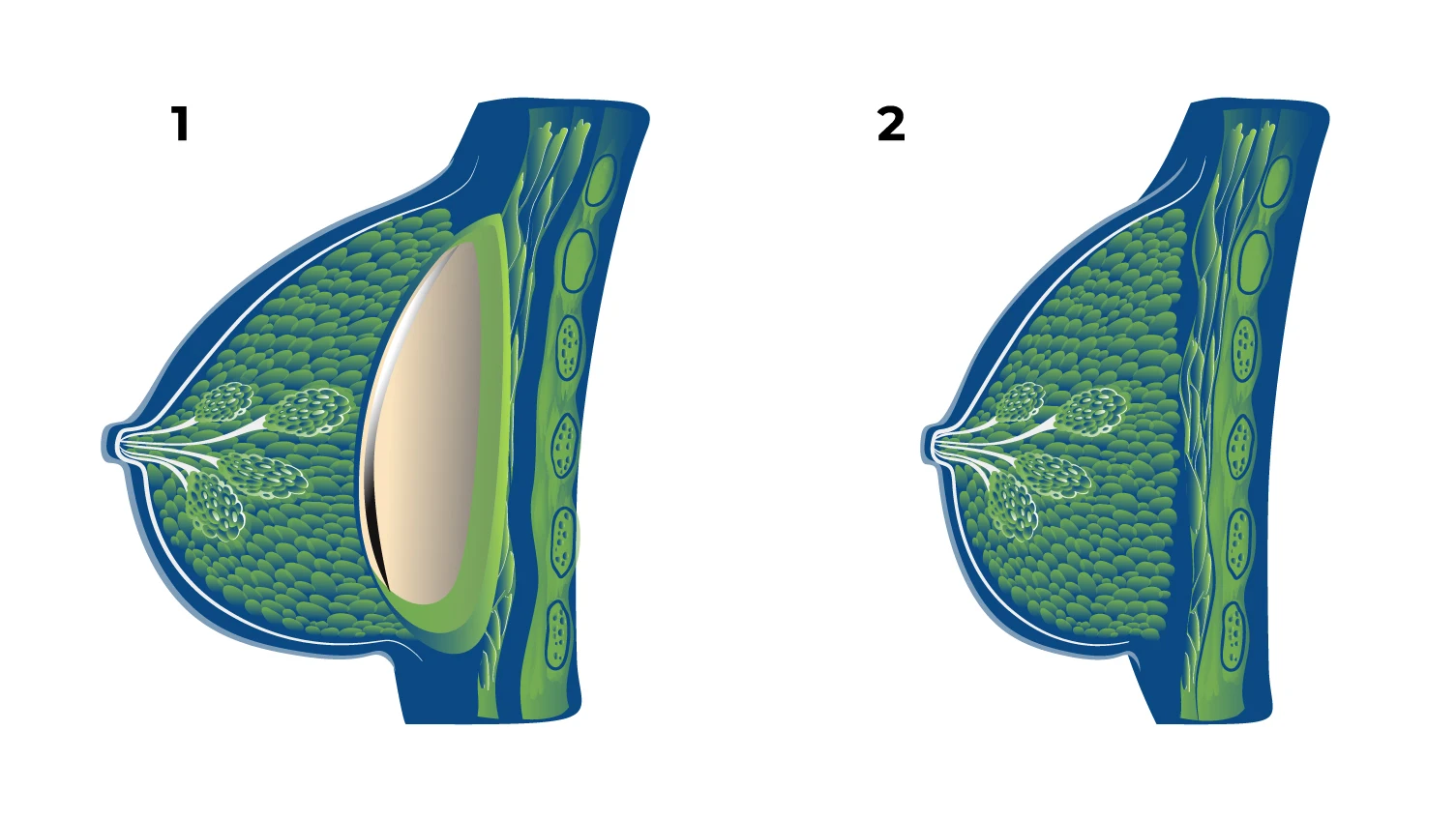Breast Implant Removal

Women choose breast implant removal for reasons including dissatisfaction with implant appearance, a desire for a more natural look, concerns about complications like implant rupture or capsular contracture, or lifestyle changes. Capsulectomy, the removal of scar tissue, may be recommended in some cases to address specific issues or ensure complete removal.
Breast Reduction and Implants
Breast implant removal, or explantation, involves the surgical removal of breast implants for various reasons such as personal preference, implant-related complications, or concerns about safety. The procedure is typically performed under general anesthesia, with the surgeon making an incision to access and carefully remove the implants. Additional steps like capsulectomy may be performed to remove scar tissue around the implants if needed.
Treatment Options
After implant removal, the breasts may appear deflated or smaller due to changes in breast tissue and skin stretching. Additional procedures like a breast lift or fat grafting can be considered to restore volume and improve breast shape if desired.
Recovery time after breast implant removal varies based on individual factors, and patients may experience temporary swelling, bruising, and discomfort. Following post-operative instructions is crucial for proper healing. The final results may take time to fully manifest as the breasts adjust to the changes.
Recovery time and results vary depending on the extent of the procedures performed. It is important to follow the surgeon’s post-operative instructions for proper healing and optimal outcomes.

Breast Reduction and Implants
Breast implant removal provides an option for individuals seeking to have their breast implants removed for different reasons. It is important to consult with a qualified plastic surgeon who can assess the specific circumstances, discuss expectations, and guide on the appropriate approach to achieve the desired results.
The success of scar revision procedures varies based on individual factors, including scar type, skin condition, and response to treatment. Consulting with a qualified dermatologist or plastic surgeon is crucial to determine the most suitable approach for scar revision based on the scar’s characteristics and location. The goal of scar revision is to minimize the visibility of scars and enhance their overall appearance, ultimately improving the individual’s confidence and self-esteem.
BREAST IMPLANT REMOVAL
Before & After
Treatment Stages
Frequently Asked Questions
Aesthetic surgery is a surgical procedure performed to correct the shape of tissues and organs. This method involves modifying tissues that have a distorted shape or size according to the patient’s desires and ideal anatomical proportions. For example, breast augmentation using silicone implants is an example of aesthetic surgery. Reconstructive surgery, on the other hand, focuses on corrective procedures. It involves the reconstruction of organs that are congenitally missing or defective, or the restoration of organs that have been lost or distorted as a result of accidents, burns, or tumor surgeries. Reconstructing a breast that was removed due to cancer is an example of reconstructive surgery.
Aesthetic surgeries are generally minimally painful procedures. Since these surgeries usually only involve the skin and subcutaneous tissues, the pain is rarely severe. Any mild discomfort experienced typically subsides within 1-2 days and can be easily managed with painkillers if necessary. However, certain surgeries that involve muscles, such as breast augmentation, may result in slightly longer-lasting pain and a sensation of tightness. Nonetheless, pain experiences can vary from person to person as each patient is unique. It is important to follow your doctor’s recommendations to minimize post-operative discomfort.
Aesthetic surgeries generally leave minimal scars. While appropriate materials and special suture techniques are used in aesthetic surgeries, it is not possible for the scars to be completely invisible. However, in aesthetic surgeries, the scars are typically concealed. For example, in rhinoplasty, the incisions are made inside the nostrils, in eyelid surgery, the incisions are made on the inside of the eyelids, and in ear surgeries, the incisions are made behind the ear. In some surgeries, it may not be possible to completely hide the scars, such as in breast reduction surgeries.
No, the carcinogenic effect of silicone has not been scientifically proven. The risk of cancer for a person with silicone implants is the same as that of a person without silicone implants. In fact, silicone implants can make it easier to detect potential breast cancer as they highlight the breast tissue during screenings.
Studies have shown that silicone implants are resilient to high and low pressures that they may encounter within the human body. The risk of rupture is extremely low.
Standard silicone implants do not have a specific lifespan. Although it is often stated that these implants can be used for a lifetime, there is a common consideration of replacing them or completely removing them after around 15 years.
Silicone implant surgery does not pose any obstacles to breastfeeding. The breastfeeding process can be carried out smoothly, as the silicone placement surgery does not cause any harm to the milk glands.
It is possible to give birth after a tummy tuck surgery, but it is important to wait at least 1 year after the operation. This period is necessary for the body to fully heal and for the post-operative effects to diminish.
Removing moles does not cause cancer. This is entirely a misconception. In fact, removing moles that are already cancerous or at risk of becoming cancerous is the most effective treatment method known today. This procedure is performed through excision, which is a surgical removal.
It is advisable to wait for at least 6 months before intervening in newly formed wounds, burns, tattoo marks, etc. During this time, the final form of the scar becomes visible and corrections can be made if necessary. Wound and burn scars cannot be completely eliminated, but they can be minimized or lightened. The success rate achieved through plastic surgery depends on factors such as the individual’s skin structure, age, the size of the scar, its location on the body, and its depth. It is important to consult with your doctor and follow their recommendations.
Plastic surgeries can be performed on individuals who are mentally and physically healthy. However, there may be age restrictions or an ideal age range for certain surgeries. For example, cleft lip surgery is typically performed on infants at 3-6 months of age, cleft palate surgery at 9-12 months, otoplasty (ear pinning) at 5-6 years old, breast augmentation and rhinoplasty (nose surgery) after 18 years of age, and facelift surgery is generally performed after the age of 40.
The risks of cosmetic surgeries primarily stem from the individual’s overall health condition, similar to other surgical procedures. In addition to that, there are specific risks associated with cosmetic surgeries, although these are rare occurrences. Since cosmetic surgeries do not involve vital organs, patients’ health or life is not put at risk.
In cases of conditions such as hypertension, diabetes, or heart disease, plastic surgeries can still be performed in a controlled manner. However, it is advisable to undergo the necessary tests and evaluations beforehand to ensure suitability for the procedure.
Cosmetic surgeries, although not as risky as surgeries involving vital organs, are procedures that require specific precautions, just like any other surgical intervention. These precautions can only be ensured with the technical infrastructure of fully equipped hospitals. It is both illegal and poses significant risks to perform cosmetic surgeries under general anesthesia in places such as clinics, dispensaries, or outpatient departments. However, minor and moderate surgeries that can be performed under local anesthesia may be conducted in clinics.
After a cosmetic surgery, it is generally possible to be discharged on the same day. In surgeries performed under general anesthesia, it is advised to stay in the hospital for 1 day for follow-up. In rare cases, it may be necessary to stay in the hospital for 2-3 days. The healing process, including the removal of bandages, casts, and stitches, is usually completed within 1 week. However, it may take weeks or months for the new shape to fully settle in.
Smoking does have an effect on aesthetic surgeries. The toxic substances in cigarettes can negatively impact tissue and wound healing. Therefore, in aesthetic surgery, smoking has a direct negative effect on the healing of surgical incisions.
No health insurance covers aesthetic surgeries. Aesthetic surgeries are typically elective procedures based on personal preferences and are not covered by health insurance policies.
To achieve excellent results after surgery, it is important to follow your doctor’s recommendations. You should adhere to post-operative dressing and follow-up appointments. Take your prescribed medications regularly. Paying attention to your doctor’s instructions is crucial in preventing potential complications and disappointments after aesthetic surgery.
The cost of cosmetic surgeries is determined based on several factors. These factors include the materials used, the duration of the surgery, the type of anesthesia, and the risks associated with the procedure. Cosmetic surgery is not just a surgical discipline but also an art, and this aspect should be carefully considered. Beyond the cost, the most important aspect is ensuring that the surgery is performed excellently.
Choosing a doctor is one of the most important decisions you will make in your life because you will be entrusting your body to that person. Finding the right surgeon to achieve the desired outcome is the fundamental step towards a successful surgery. Therefore, it is important to take the time to find the surgeon who will perform the best surgery possible.
Asking for recommendations from your close circle, especially from someone who has undergone the same surgery before, is one of the most effective methods. Your acquaintances who work in the healthcare industry can also be a valuable source of advice. They have firsthand experience of the surgeon’s demeanor, expertise, and comfort level during the surgery, so they can provide valuable insights. Therefore, anesthesiologists and surgical nurses should also be among the first people you consult with.
If you don’t know anyone from these professional groups, another way to conduct research is by visiting the hospital where the surgeon performs surgeries. You can gather information by speaking with hospital staff who can assist you in your inquiry.
One of the biggest mistakes when choosing a surgeon is assuming that every surgeon can perform the same procedure without considering their personal experience. Instead of focusing solely on price, it is important to prioritize the surgeon’s specialization, education, experience, manual dexterity, and the frequency with which they have performed the specific procedure you are interested in
Factors such as the surgeon’s frequency of keeping up with medical advancements, participation in conferences and courses, and publications in scientific journals should also be taken into consideration. It is important to choose a surgeon who constantly updates their knowledge and stays informed about the latest developments in surgical procedures. Additionally, being a member of the national aesthetic surgery association in their country is an important criterion for reliability.
The location where the surgeon performs the surgeries and the quality of the hospital are indeed important considerations. A conscientious surgeon who prioritizes health and safety should not compromise on the quality of the hospital.
The ability of the surgeon to recognize and promptly address any unforeseen complications that may arise during or after surgery should also be taken into consideration. Therefore, it is important to choose a surgeon who specializes in aesthetic plastic surgery.
Patient Registration Form
SmyrnaMED
Rediscover Your Beauty...
If you are looking for a reliable, friendly, and people-centered approach in the field of Aesthetic Plastic Surgery, Dental Treatment and Hair Transplantation, you are in the right place. SmyrnaMED is just a phone call away.
